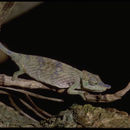Biology
provided by Arkive
Chameleons are generally solitary and move about on slender branches and twigs, gripping with their fused toes. The prehensile tail provides an additional 'hand' on this precarious walkway as they scan the surrounding area with their independently mobile eyes for small insect prey (4). When sleeping or resting, the big-nosed chameleon is said to position itself head downwards as it clings to a narrow twig or vine (3).
In captivity, female big-nosed chameleons have been recorded producing several clutches of two to six eggs each year (3). These eggs are incubated for about 90 days, at a temperature of around 23 degrees Celsius (2) (3).
Conservation
provided by Arkive
The big-nosed chameleon is listed on Appendix II of the Convention on International Trade in Endangered Species (CITES), so that any international trade in this species that does occur should be carefully monitored (1). There are currently no other known conservation measures in place specifically for the big-nosed chameleon, but the government of Madagascar, along with many local and international conservation organisations, are working to conserve the unique biodiversity of this remarkable island (6) (7).
Description
provided by Arkive
One of the smallest of the arboreal chameleons (3), the big-nosed chameleon is named for the large, paddle-like appendage which projects from the nose region (2). This flexible appendage is larger and more square-shaped on males, and is believed to be used to recognise potential mates (2). Male big-nosed chameleons can also be distinguished by the more pronounced casque, a bony head crest (2). The skin of both sexes is usually a shade of brown, reddish-brown, tan, or light green (2) (3), with females not receptive to mating rapidly developing a striking display of whitish-blue to turquoise spots on top of the head and on the sides of the nasal appendage (2). Like other chameleons, this big-nosed species has a prehensile tail, fused toes, distinctive turret-like eyes and an impressively long tongue (4).
Habitat
provided by Arkive
The big-nosed chameleon inhabits primary forest, forest edge and secondary forest where it is found in low vegetation, generally one to two metres above the ground (2).
Range
provided by Arkive
Occurs in the humid regions of eastern and northern Madagascar (2).
Status
provided by Arkive
Listed on Appendix II of CITES (1).
Threats
provided by Arkive
Unlike many other chameleons, the big-nosed chameleon is believed to not be currently threatened by collection for the international pet trade (1); however, other reports indicate that the trade in this species is slowly starting to grow (3). While the big-nosed chamelone has a relatively large distribution, low densities of this species recorded in some areas indicate that certain populations may be at risk from any potential threats (5), such as the habitat destruction impacting many of Madagascar's incredible reptiles (4).
Distribution
provided by ReptileDB
Continent: Indian-Ocean
Distribution: Nossi Be = Nosy Bé, N , E Madagascar, Nosy Komba
Type locality: Madagascar
Calumma nasutum
provided by wikipedia EN
Calumma nasutum, the Madagascar pimple-nose chameleon, is a small species of chameleon found in Madagascar.[1][2] The taxonomic identity of the species is currently uncertain and in need of revision, and this revision is likely to result in several newly described species.[3] Several different data sets indicate that C. nasutum is a complex of several species.[4]
Taxonomy
Calumma nasutum belongs to the so-called "C. nasutum species group" within the genus Calumma. This group is a phenetic one, and has been reconstructed by some studies as being polyphyletic,[5] but the species are unified by their small size and possession of a soft dermal appendage at the front of the nose ("rostral appendage"). The group currently consists of C. nasutum, C. fallax, C. gallus, C. vohibola, C. vatosoa, C. radamanus, C. peyrierasi, C. boettgeri, and C. linotum.[3][6]
Calumma nasutum itself is a member of a species complex. Gehring et al.[3] showed that there were numerous genetic lineages in the Calumma nasutum group, which they divided into 33 Operational Taxonomic Units (OTUs). It was not clear which of these OTUs belongs to the 'real' C. nasutum, or the differences between it and C. fallax, which is morphologically similar.[3]
References
-
^ a b Jenkins, R.K.B.; Andreone, F.; Andriamazava, A.; Anjeriniaina, M.; Brady, L.; Glaw, F.; Griffiths, R.A.; Rabibisoa, N.; Rakotomalala, D.; Randrianantoandro, J.C.; Randrianiriana, J.; Randrianizahana , H.; Ratsoavina, F.; Robsomanitrandrasana, E. (2011). "Calumma nasutum". IUCN Red List of Threatened Species. 2011: e.T172861A6931331. doi:10.2305/IUCN.UK.2011-2.RLTS.T172861A6931331.en. Retrieved 12 November 2021.
-
^ "Calumma nasutum (DUMÉRIL & BIBRON, 1836)". /reptile-database.reptarium.cz. Retrieved 19 August 2013.
-
^ a b c d Gehring, Philip-Sebastian; Tolley, Krystal A.; Eckhardt, Falk Sebastian; Townsend, Ted M.; Ziegler, Thomas; Ratsoavina, Fanomezana; Glaw, Frank; Vences, Miguel (2012-07-01). "Hiding deep in the trees: discovery of divergent mitochondrial lineages in Malagasy chameleons of the Calumma nasutum group". Ecology and Evolution. 2 (7): 1468–1479. doi:10.1002/ece3.269. ISSN 2045-7758. PMC 3434913. PMID 22957155.
-
^ Glaw, Frank; Vences, Miguel (2007). A Field Guide to the Amphibians and Reptiles of Madagascar (3rd ed.). Cologne, Germany: Vences & Glaw Verlags. ISBN 978-3929449037.
-
^ Tolley, Krystal A.; Townsend, Ted M.; Vences, Miguel (2013-05-22). "Large-scale phylogeny of chameleons suggests African origins and Eocene diversification". Proceedings of the Royal Society of London B: Biological Sciences. 280 (1759): 20130184. doi:10.1098/rspb.2013.0184. ISSN 0962-8452. PMC 3619509. PMID 23536596.
-
^ Prötzel, David; Ruthensteiner, Bernhard; Scherz, Mark D.; Glaw, Frank (2015-11-25). "Systematic revision of the Malagasy chameleons Calumma boettgeri and C. linotum (Squamata: Chamaeleonidae)". Zootaxa. 4048 (2): 211–31. doi:10.11646/zootaxa.4048.2.4. ISSN 1175-5334. PMID 26624746.

- license
- cc-by-sa-3.0
- copyright
- Wikipedia authors and editors
Calumma nasutum: Brief Summary
provided by wikipedia EN
Calumma nasutum, the Madagascar pimple-nose chameleon, is a small species of chameleon found in Madagascar. The taxonomic identity of the species is currently uncertain and in need of revision, and this revision is likely to result in several newly described species. Several different data sets indicate that C. nasutum is a complex of several species.
- license
- cc-by-sa-3.0
- copyright
- Wikipedia authors and editors

